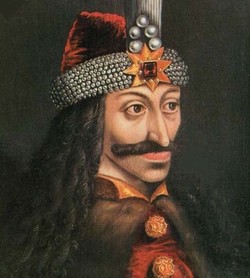|
|
 |
|
|
 |
 |
 |
 |
 |
 |
 |
 |
 |
|
The Vampires ar a rase that had existed since the Dark Ages. One of the most known vampires is an
XV-th century romanian leader.
|
In 1447, his father, Vlad Dracul was assasinated by the Danesti family and with the support of John
Hunyadi (Iancu de Hunedoara), Vladislav II captured the Wallachian throne.¬ Mircea, Dracula's eldest brother, had been tortured and¬ buried alive by
the boyars (nobles) of Targoviste. In 1448 with the Turks support, Vlad Tepes managed to seize the throne, but lasted only two month. Hunyadi forced Dracula to
surrender the throne to Vladislav II (known as Vlad II). Dracula fleed to Moldavia, where remained until 1451 when Prince Bogdan of Moldavia was
assasinated,¬ and Vlad was forced to flee to Transylvania and asked his enemy, John Hunyadi, for protection. Hunyadi accepted the allegiance and Dracula
became Hunyadi's vassal and received his father's old Transylvanian duchies of Fagaras and Almas. He remained in Transylvania until 1456.
|
|
|
|
|
|
Fifteenth century Wallachian prince Vlad Tepes is credited with being Dracula, the vampire-count featured
in the classic horror story Dracula (1897) written by novelist Bram Stroker. Romanians make no association between the vampire and the historical figure of prince
Vlad III, known in his homeland as Vlad Tepes (Vlad the Impaler), prince of Wallachia three times, in 1448, 1456-1462 and 1475. Vlad achieved renown beyond
Wallachia's borders as a successful fighter against the Turks and a ruthless ruler. Notorious for his brutal punishment methods, he gained the name Tepes (impaler)
after his favourite form of punishing his enemies - impaling on a wooden stake. His method of law enforcement was simple: all crimes and individuals offending him
were punished by death.The offenders would have to die in agony. Impaling was not unique in Europe. Tepes first cousin, Stephen the Great, is said to have impaled
over 2300 Turkish prisoners in 1473.
|
|
|
|
|
|
|
Commonly known as Dracula's Castle, the Bran Castle was originally a stronghold built by the Knights
of Teutonic Order in 1212. The first documentary attestation of the Bran Castle is the act issued on November 19, 1377, giving the Saxons of Kronstadt (Brasov) the
privilage to build the Citadel. The building started in 1378 as a defense against Turks and later became a customs post on the pass between Transylvania and
Wallachia. From 1920 the castle became a royal residence until the expulsion of the royal family in 1948. On 1st October 1950, the Bran Castle was declared a
historical monument. Today it functions as a very attractive museum of medieval arts.
|
|
|
|
|
|
|
|
|
|
|



